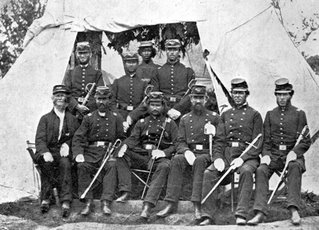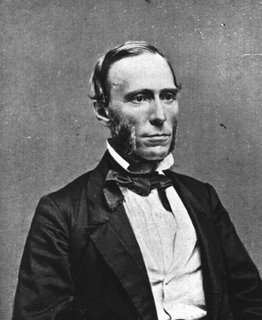At 8:30 on the morning of Thursday, June 13, 1861, the ten companies of the Third Michigan infantry, led by its regimental band and the field and staff officers, left their quarters at "Cantonment Anderson". The camp had been established on the site of the county fairgrounds, about two and a half miles south of the city of Grand Rapids. (This cantonment or camp would eventually serve as the staging depot for several more regiments that would be formed in western Michigan. Later on in the war the staging facilities were moved just to the edge of town, near the site of the present Central High School, in order to be closer to the railhead which was located north of the city.)
The Third Michigan marched north up the Kalamazoo Plank road into the city, turned down Monroe street to Canal street and headed north to the Detroit & Milwaukee railroad depot, near what is today the corner of Plainfield and Leonard streets.
Upon reaching the train station, the men boarded two special trains heading east, passing through Ada, St. Johns, Owosso, Pontiac and terminated in Detroit, where the Third Michigan was feted by the citizens. (photo: Third Michigan marching down Jefferson ave. in Detroit, June 3, 1861; from the New York Illustrated News, July 11, 1861.)

The Regiment then boarded two boats for a night cruise to Cleveland, Ohio. From Cleveland they went by rail to Pittsburgh, Pennsylvania and then on to Harrisburg, Baltimore, Maryland, and finally arrived in Washington, DC, on Sunday June 16. They were tired, hungry and weary when they marched to Chain Bridge just above Georgetown on the Potomac river, where they set up their first wartime encampment on the bluffs overlooking the river. (photo: Camp Blair.)


The camp was first called Camp McConnell (after Daniel McConnell, the colonel of the regiment) but then quickly changed to Camp Blair, after Austin Blair (photo below), then governor of the state of Michigan. (photo above: taken at Camp Blair near the Potomac in July of 1861 -- first row (l-r) Chaplain Francis Cuming, Lt. Col. Ambrose Stevens, Col. Dan McConnell, Maj. Stephen Champlin, Drs. D. Willard and his brother Zenas Bliss; far back is Dan Bronson Col. McConnell's servant.)

The bands, the crowds, the patriotic fervor of late April soon give way to war’s harshest reality: death. The first man to die was William Choates of C company, who passed away on July 1, 1861, not amidst the glories of battle but in the throes of fever. He was buried near Camp Blair, and is presumably buried there still. The regiment’s baptism into war came less than three weeks later in the action at Blackburn’s Ford on July 18, 1861, a prelude to the first battle of Bull Run on July 21. The Third suffered its first wartime casualty early on Saturday morning, July 20, 1861, when Homer Morgan of B company allegedly took his own life.
The Third Michigan infantry covered the retreat of the federal troops from Bull Run on July 21, and subsequently went into a succession of camps around Washington throughout the fall and winter of 1861-62. The regiment participated in McClellan’s Peninsular campaign of 1862 and suffered its worst casualties to date at Fair Oaks, Virginia on May 31, 1862 and at Groveton (or Second Bull Run) on August 29, 1862. The Third Michigan infantry played a peripheral part in the battle of Fredericksburg on December 13, 1862.
The next major action for the regiment was at Chancellorsville, Virginia, on May 3, 1863, followed by Gettysburg where the Third found itself exposed in the Peach Orchard on July 2, 1863.
Near the end of the summer of 1863 the Third Michigan was detached to the Department of the East under General Dix and sent northward to New York City in late August to serve as a deterrent to the expected rioting in the upcoming draft in that state. The Regiment spent several days in New York City, the draft went off without event and the Third Michigan was sent up the Hudson River to Troy to oversee the draft in that city, where it remained for two weeks before it returned south to rejoin the Army of the Potomac. Between December 21 and 24, 1863, while camped at Camp Pitcher, near Brandy Station, Virginia, 178 men reenlisted for another three years or “during the war”.
By early May of 1864, the Army of the Potomac was again on the move in Virginia and the Third Michigan was hotly engaged in on May 5-6 at the Wilderness and on May 11-12 at Spotsylvania Court House. The Regiment also participated in Grant’s sidestepping moves southeastward around Lee’s right flank across the North Anna river.
The Third Michigan formally ended its military service in the trenches in front of Petersburg, Virginia, on June 10, 1864, and was mustered out of federal service that same day. Those men who had enlisted in June of 1861 but who had not reenlisted were sent home to be mustered out in Detroit on June 20, while the remainder of the regiment, reenlisted “veterans” and recent enlistees, were incorporated into four companies (A, E, F, and I) and then consolidated into the Fifth Michigan infantry.
The history of the Regiment as an integral component of the Union military structure was over, but its history as a relic of that conflict, as a symbol of what that struggle represented would continue to linger on in the guise of the Third Michigan Association until well into the next century, indeed until every member had passed away.
Next: How many joined?
The Third Michigan marched north up the Kalamazoo Plank road into the city, turned down Monroe street to Canal street and headed north to the Detroit & Milwaukee railroad depot, near what is today the corner of Plainfield and Leonard streets.
Upon reaching the train station, the men boarded two special trains heading east, passing through Ada, St. Johns, Owosso, Pontiac and terminated in Detroit, where the Third Michigan was feted by the citizens. (photo: Third Michigan marching down Jefferson ave. in Detroit, June 3, 1861; from the New York Illustrated News, July 11, 1861.)

The Regiment then boarded two boats for a night cruise to Cleveland, Ohio. From Cleveland they went by rail to Pittsburgh, Pennsylvania and then on to Harrisburg, Baltimore, Maryland, and finally arrived in Washington, DC, on Sunday June 16. They were tired, hungry and weary when they marched to Chain Bridge just above Georgetown on the Potomac river, where they set up their first wartime encampment on the bluffs overlooking the river. (photo: Camp Blair.)


The camp was first called Camp McConnell (after Daniel McConnell, the colonel of the regiment) but then quickly changed to Camp Blair, after Austin Blair (photo below), then governor of the state of Michigan. (photo above: taken at Camp Blair near the Potomac in July of 1861 -- first row (l-r) Chaplain Francis Cuming, Lt. Col. Ambrose Stevens, Col. Dan McConnell, Maj. Stephen Champlin, Drs. D. Willard and his brother Zenas Bliss; far back is Dan Bronson Col. McConnell's servant.)

The bands, the crowds, the patriotic fervor of late April soon give way to war’s harshest reality: death. The first man to die was William Choates of C company, who passed away on July 1, 1861, not amidst the glories of battle but in the throes of fever. He was buried near Camp Blair, and is presumably buried there still. The regiment’s baptism into war came less than three weeks later in the action at Blackburn’s Ford on July 18, 1861, a prelude to the first battle of Bull Run on July 21. The Third suffered its first wartime casualty early on Saturday morning, July 20, 1861, when Homer Morgan of B company allegedly took his own life.
The Third Michigan infantry covered the retreat of the federal troops from Bull Run on July 21, and subsequently went into a succession of camps around Washington throughout the fall and winter of 1861-62. The regiment participated in McClellan’s Peninsular campaign of 1862 and suffered its worst casualties to date at Fair Oaks, Virginia on May 31, 1862 and at Groveton (or Second Bull Run) on August 29, 1862. The Third Michigan infantry played a peripheral part in the battle of Fredericksburg on December 13, 1862.
The next major action for the regiment was at Chancellorsville, Virginia, on May 3, 1863, followed by Gettysburg where the Third found itself exposed in the Peach Orchard on July 2, 1863.
Near the end of the summer of 1863 the Third Michigan was detached to the Department of the East under General Dix and sent northward to New York City in late August to serve as a deterrent to the expected rioting in the upcoming draft in that state. The Regiment spent several days in New York City, the draft went off without event and the Third Michigan was sent up the Hudson River to Troy to oversee the draft in that city, where it remained for two weeks before it returned south to rejoin the Army of the Potomac. Between December 21 and 24, 1863, while camped at Camp Pitcher, near Brandy Station, Virginia, 178 men reenlisted for another three years or “during the war”.
By early May of 1864, the Army of the Potomac was again on the move in Virginia and the Third Michigan was hotly engaged in on May 5-6 at the Wilderness and on May 11-12 at Spotsylvania Court House. The Regiment also participated in Grant’s sidestepping moves southeastward around Lee’s right flank across the North Anna river.
The Third Michigan formally ended its military service in the trenches in front of Petersburg, Virginia, on June 10, 1864, and was mustered out of federal service that same day. Those men who had enlisted in June of 1861 but who had not reenlisted were sent home to be mustered out in Detroit on June 20, while the remainder of the regiment, reenlisted “veterans” and recent enlistees, were incorporated into four companies (A, E, F, and I) and then consolidated into the Fifth Michigan infantry.
The history of the Regiment as an integral component of the Union military structure was over, but its history as a relic of that conflict, as a symbol of what that struggle represented would continue to linger on in the guise of the Third Michigan Association until well into the next century, indeed until every member had passed away.
Next: How many joined?
1 comment:
I have an ancestor that died at Camp Blair - just three weeks after leaving Grand Rapids, MI. His name is David Gitchel (from Jamestown, Michigan) - anyone have a clue as to where his body might be buried? Was there a specific site at Camp Blair that they buried their dead? Does anyone have a map that shows where Camp Blair is actually located (specific spot)?
Post a Comment